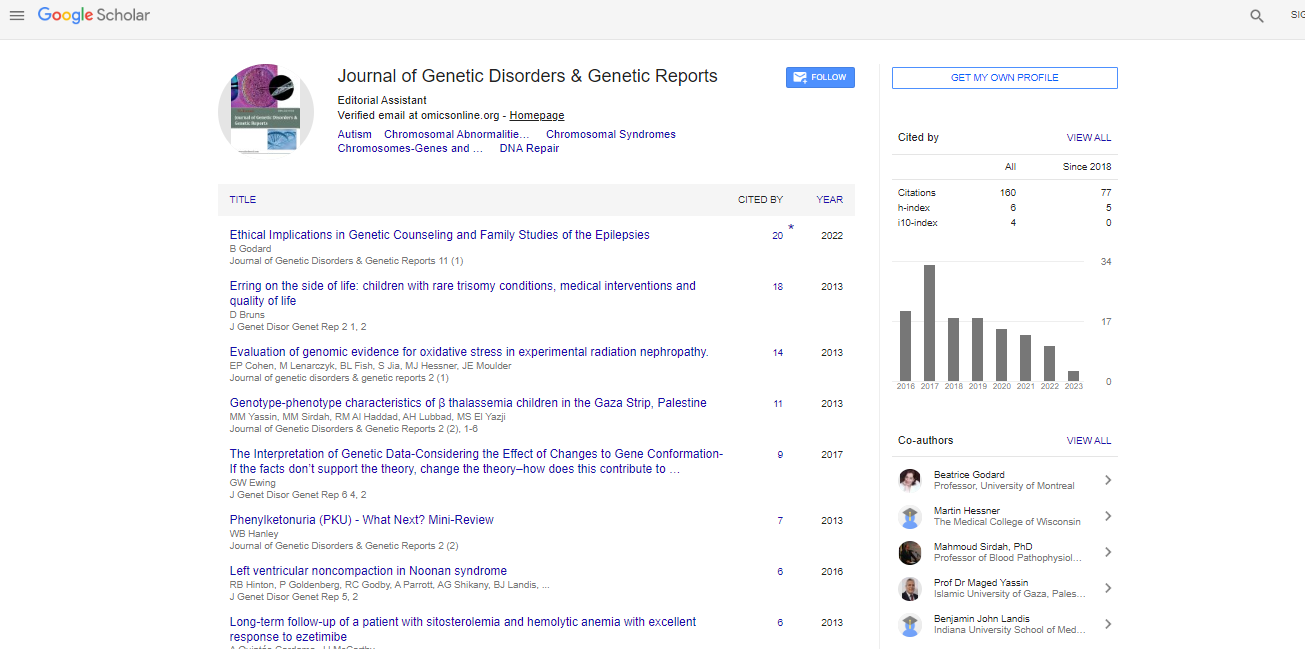Opinion Article, Vol: 12 Issue: 2
Multifactorial and Polygenic Disorders: Unraveling the Complexity of Genetic Contributions
Kasturi Haldar*
1Department of Hematology, and the Global Health Center, Cincinnati Children’s Hospital Medical Center, Cincinnati OH 45229, USA
*Corresponding Author: Kasturi Haldar,
Department of Hematology, and the
Global Health Center, Cincinnati Children’s Hospital Medical Center, Cincinnati OH
45229, USA
E-mail: kasturihaldar2468@nd.edu
Received date: 29 March, 2023, Manuscript No. JGDGR-23-99530;
Editor assigned date: 31 March, 2023, Pre QC No. JGDGR-23-99530 (PQ);
Reviewed date: 14 April, 2023, QC No. JGDGR-23-99530;
Revised date: 21 April, 2023, Manuscript No. JGDGR-23-99530 (R);
Published date: 28 April, 2023, DOI: 10. 4172/2576-1439.1000195
Citation: Kasturi H (2023) Multifactorial and Polygenic Disorders: Unraveling the Complexity of Genetic Contributions. J Genet Disor Genet Rep 12:2.
Abstract
Human health and disease are influenced by a combination of genetic and environmental factors. Multifactorial and polygenic disorders, characterized by the interplay of multiple genetic and environmental components, represent a significant portion of the disease. Understanding the complexities of these disorders is crucial for improving diagnosis, prevention, and treatment strategies. By shedding light on the intricate nature of these disorders, hope to promote awareness and inspire further research in unraveling their mysteries.
Description
Human health and disease are influenced by a combination of genetic and environmental factors. Multifactorial and polygenic disorders, characterized by the interplay of multiple genetic and environmental components, represent a significant portion of the disease. Understanding the complexities of these disorders is crucial for improving diagnosis, prevention, and treatment strategies. By shedding light on the intricate nature of these disorders, hope to promote awareness and inspire further research in unraveling their mysteries.
Multifactorial disorders
Multifactorial disorders, also known as complex disorders, result from a combination of genetic and environmental factors. These disorders do not follow a simple Mendelian inheritance pattern but instead involve the interaction of multiple genes with environmental influences. Examples of multifactorial disorders include heart disease, diabetes, asthma, and psychiatric disorders.
Genetic factors: Multifactorial disorders have a genetic component, although they are not caused by a single gene mutation. Genetic variations, such as Single Nucleotide Polymorphisms (SNPs), contribute to disease susceptibility. Each individual variant may have a small effect on disease risk, but when combined with other genetic and environmental factors, they can collectively influence disease development.
Environmental factors: Environmental factors play a significant role in multifactorial disorders. These can include lifestyle choices (e.g., diet, physical activity), exposure to toxins, infections, and socioeconomic factors. Environmental influences can modify gene expression and interact with genetic variants to influence disease outcomes.
Polygenic disorders: The Influence of Multiple Genes Polygenic disorders are a specific subset of multifactorial disorders characterized by the involvement of multiple genes. In contrast to monogenic disorders, which are caused by mutations in a single gene, polygenic disorders arise due to the combined effect of multiple genetic variations. Examples of polygenic disorders include cardiovascular disease, obesity, and certain types of cancer.
Polygenic risk scores: Polygenic Risk Scores (PRS) are used to quantify an individual's genetic risk for developing a specific disorder. PRS are calculated by summing the contribution of multiple genetic variants associated with the disease. The cumulative effect of these variants helps predict an individual's susceptibility to the disorder, although it does not guarantee its occurrence.
Genome-Wide Association Studies (GWAS): GWAS have revolutionized the understanding of polygenic disorders by identifying genetic variants associated with disease risk. GWAS analyze hundreds of thousands to millions of genetic markers across the genome to detect associations with specific traits or diseases. These studies have revealed numerous genetic loci that contribute to polygenic disorders, providing valuable insights into disease mechanisms.
Risk factors and predictive models
Family history: A positive family history of a disorder is a significant risk factor for multifactorial and polygenic disorders. Individuals with affected first-degree relatives have a higher risk of developing the disorder compared to the general population. Family history provides valuable information for risk assessment and genetic counseling.
Gene-environment interactions: Multifactorial and polygenic disorders are influenced by interactions between genetic factors and environmental exposures. For instance, the risk of developing lung cancer may be higher in individuals with specific genetic variants who are exposed to tobacco smoke. Identifying gene-environment interactions is essential for understanding disease development and designing targeted interventions.
Predictive models: Advances in computational genetics have allowed the development of predictive models.
 Spanish
Spanish  Chinese
Chinese  Russian
Russian  German
German  French
French  Japanese
Japanese  Portuguese
Portuguese  Hindi
Hindi 



